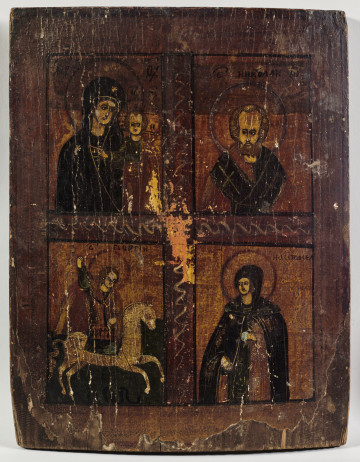
A multi-field icon, the Mother of God Odigitria of Kazan; the Resurrection of Christ; St. Nicholas, Archangel with saints; St. Barbara; St. George the Martyr, St. Catherine
2nd half of the 19th century
Castle Museum in Łańcut
Part of the collection: Ikony
The term Deesis, meaning “supplication” or “petition” in Greek, was formed based on liturgical texts in which the Church appeals to the intercession of saints in a supplicatory prayer before the enthroned Saviour. The figurative form of Deesis has been present in Eastern Christianity since the 6th-7th centuries. With the development of the multi-tiered icon screen in Russia during the 16th-17th centuries, Deesis became one of the rows of the iconostasis. In its basic depiction, three figures are presented: Christ Pantocrator, the Almighty, enthroned, and the two greatest intercessors for humanity, the Mother of God and St. John the Baptist, who represent all humankind. They embody the mystery of the Incarnation of the Saviour (accomplished with the participation of the Mother of God) and attested by John (the outpouring of the Holy Spirit on the Son of God during His baptism in the Jordan). Alongside the basic depiction, there are more elaborate versions that include figures of Archangels, representing the invisible angelic world, Apostles, and other saints, all arranged hierarchically. On the presented Russian icon, in addition to the mentioned figures, we see John the Evangelist, St. Nicholas the Wonderworker, as well as Zosimas and Sabbatius of Solovki. In the tradition of Russian Orthodoxy, such representations of Deesis were commonly called "sedmitsa" (meaning "the seven"), in reference to the days of the week. Each day is dedicated to the commemoration of a saint or feast: Sunday commemorates the Resurrection, Monday is dedicated to the Heavenly Hosts, Tuesday to John the Baptist, Wednesday to the Mother of God, Thursday to the Apostles and St. Nicholas the Wonderworker, Friday to the Crucifixion of Christ, and Saturday to all the saints.
Teresa Bagińska-Żurawska https://orcid.org/0000-0002-9243-3967
Author / creator
Object type
ikony
Technique
tempera, pozłotnictwo
Material
wood, chalk, distemper, gold
Creation time / dating
Creation / finding place
Owner
Muzeum - Zamek w Łańcucie
Identification number
Location / status

2nd half of the 19th century
Castle Museum in Łańcut

XIX/XX wiek
Castle Museum in Łańcut

początek XX w.
Castle Museum in Łańcut
DISCOVER this TOPIC
National Museum in Szczecin
DISCOVER this PATH
Educational path